
|   |

|   |
 e-mail: sunilkothari1933@gmail.com Patna Diary Photos: Dr. Sunil Kothari November 19, 2017 I had visited Patna some 20 years ago; the last visit was to Rajgir Dance Festival. Therefore visiting Patna once again evoked nostalgia. The first visit was in 1965 with Manipuri dancers, the Jhaveri Sisters. On our way to Kathmandu, Nepal, they were performing at the Indian Embassy. Young Priyamvada, daughter of Dr V. Raghavan and disciple of late T.Balasaraswati, gave a Bharatanatyam performance. We had stayed overnight at Bharatiya Nritya Kala Mandir established by late Hari Uppal, a disciple of Guru Atomba Sharma at Shantiniketan. He had studied Kathakali also there under Kelu Nair. He was one of the four organizers for the All India Dance Seminar convened by Sangeet Natak Akademi in 1958. We had remained in touch. He was extremely hospitable and looked after us showing us his disciples in Manipuri and Kathakali. There were also Bharatanatyam classes run by a young dancer. Her name escapes me. Hari Uppal's daughter Stella Uppal studied Bharatanatyam at Kalakshetra and participated in Buddhavatara dance-drama choreographed by Rukmini Devi. She has moved to London where she performs and teaches Bharatanatyam. The second visit was after nearly ten years, sometime in 1975 with Navanit Parekh, cousin of sitar maestro Aravind Parikh, who has been elected Fellow of SNA this year. We were guest of Mr. Jalan, a connoisseur and collector of miniature paintings and rare items like original sword of Akbar! Lovers of paintings and rare objects invariably visit his museum called Qila House, in the thick of the old Patna city. I have distinct memory of our visiting Ganga Ghat from where I had seen the vast Ganga River. 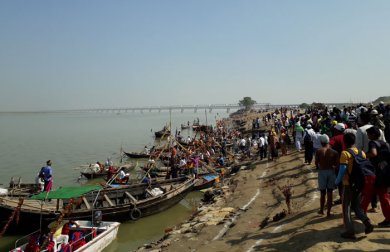 By a happy coincidence, during our stay the 10th National Ganga River long distance swimming championship 2017 was on, organized by Swimming Federation of India in association with Takshila. Our host Sanjiv Kumar is a patron of arts. Founder of Delhi Public School, besides in Patna, he has built other Delhi Public Schools in Coimbatore, Ludhiana and other cities. A great supporter of SPIC MACAY movement and firm believer in acquainting young generation with classical music and dance forms, he extends his patronage to various arts, including theatre, paintings, sculptures, for workshops in rural areas. His colleague Yashwant Parashar is a trained musician, having studied flute from Harshavardhan. Also a supporter of SPIC MACAY movement and believing in spirit of voluntarism, he looks after the festival with a team of school teachers. Maya Shankar, who headed SPIC MACAY movement in Bihar, is another dynamic person. Wife of Union Minister Ravi Shankar Prasad, Maya is very fond of music and dance. Principal of Women's College in Bihar and a social activist, she has several interests besides education. On the second day of our stay, Sanjiv Kumar suggested we accompany him to Ganga Ghat where for swimming competition participants from more than twenty five states from India had arrived. The young participants swim across Ganga for 21 kilometers and those who come first receive the prize. The Ganga Ghat was all agog with innumerable visitors and local crowds. Several boats were anchored near the Ghat. When the whistle was blown to begin the competition, various boats accompanied the participants. The scene was in the nature of a festival. Across the river now a five kilometer bridge has come up connecting two banks of the Ganga. To go to Sonpur across the bridge takes mere twenty minutes by car. At this time a fair takes place with lot of fun fare. From the time we arrived at Patna, everyone was talking of the new Bihar Museum which was inaugurated by Chief Minister Nitish Kumar on 2nd October. It is one of the most outstanding architectural wonders built at cost of Rupees 500 crores. It is spread in 13.5 acres at Bailly Road in the heart of Patna. Only three sections of the museum - children's section, main entrance area and orientation theatre - are thrown open to the public. The work is still going on to complete other sections of the museum. The CM Nitish Kumar had laid the foundation stone of the museum in 2013. It was originally to open on Bihar Diwas (March 22) this year but it got delayed. Canada-based Lord Cultural Resources - the world's largest and leading firm specializing in the planning and management of museums - is the consultant for the project. 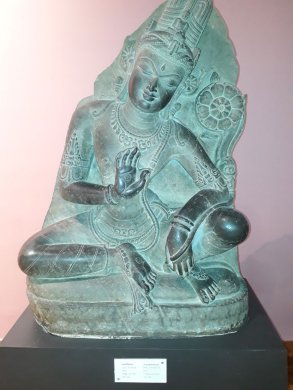 Avalokiteswara 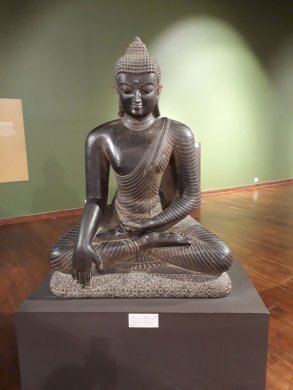 Buddha (5th c) 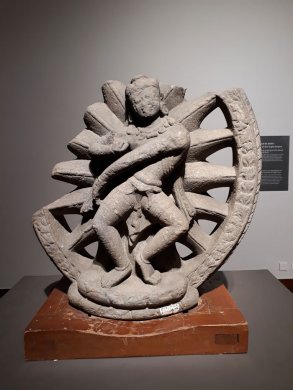 Karthikeya 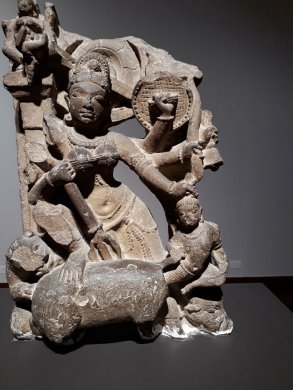 Mahishasuramardhini (10th c) Patna known as Patliputra has a long chequered history and boasts of Bihar Museum known for collection of sculptures of Mauryan period. The renowned sculpture of Didarganj Yakshini is world famous. Known for rare objects of metal sculptures, terracotta, stone sculptures, Tibetan scroll paintings known as Thankas, most of the collections have been now transferred to the new museum. However, a visit to the old museum was quite rewarding as the rare collection of Thankas is still there. The great scholar Rahul Sanskrityayan had visited Tibet in 1929 and during his stay there for more than 15 months, not only did he study Tibetan language but also made deep study of Buddhism. He collected rare manuscripts, Thanka paintings, and sculptures and loaded them on 22 horses crossing the various boundaries and hills. Thanks to Dr Kashi Prasad Jayswal, another great scholar and friend of Rahul Sanskrityayan, this entire collection was kept at Bihar Museum. Reading the details and seeing those marvellous Thanka paintings I was quite overwhelmed. Thankas are inspired by mural paintings and are done on cloth. They cover rivers, mountains, vegetation, and innumerable Buddhist gods and goddesses. Though colours of some Thankas have been fading, majority are well preserved. The museum has more than 100 Thankas and 25 block prints. The noteworthy ones are of 11 faced Avalokiteshwara, Amoghpasha, Manjushri, Tara, Amitabha and fierce tantric gods and goddesses. In the tradition of Dalai Lama, Thanka paintings belonging to 7 Dalai Lamas are in collection of Bihar Museum. The metal sculptures abound from Maurya, Gupta, and Kushan period and besides Buddha sculptures, the Jain Tirthankaras' sculptures are equally important. The method of Lost Wax process employed earlier has resulted in leaving behind a great treasure. One of 11th century Balaram was noteworthy. Some are gilded with gold. By a happy coincidence the stone sculpture of Didarganj Yakshini was still in old museum. Carved in 3rd century BC it is one of the finest sculptures of Mauryan period, the stone shines and looks polished. Didarganj Yakshini holds chowrie - chamar - fly whisk, the full size statue is 7 feet tall and the note below mentions opinions of several scholars including Vasudev Sharan Agrawal praising it as one of the most attractive female sculptures of Mauryan period. There are also several Yaksha-Yakshi sculptures. But one of Didarganj excels all of them. 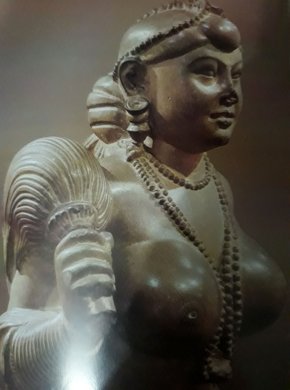
Didarganj Yakshini
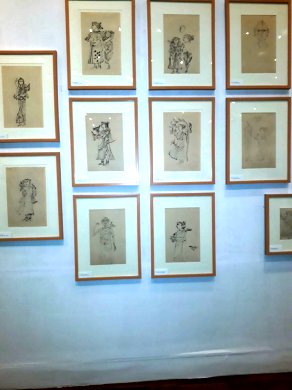 Paintings of K.G. Subramaniam Unfortunately barring a few leaflets, the old museum does not provide any catalogues or prints. The sculptures now transferred to new museum are displayed beautifully in large space and with excellent lighting. In some cases, coloured cloth is kept as a backdrop. What is fascinating is the vast space and one can move around and see the sculptures from various angles. There was also exhibition of celebrated painter late K.G. Subramaniam which had opened on the day I visited the museum. No photographs of the new museum were available. It is so vast that no way could I photograph it. However, in due course the authorities will bring out a book on the museum and its architecture. Since there is no other museum so vast and with latest state of art technique and facilities, it would help visitors to take with them some memories. I recommend all dancers and readers of my column to make it a point to visit the museum when in Patna. Patna offered us opportunity to stay together and exchange views on state of the arts. The hospitality was excellent. We all lamented the shrinking space for art coverage in print media and appreciated the efforts and vision of Managing editor Dr. Anita Ratnam and her team of Narthaki.com that offers the dancers and world of dance to get united with such other artistic experiences. Engrossing mythological tales: Tripurasamhara and Abhimanyuvadha Photos courtesy: Vanashree Rao Husband and wife team Vanashree and Guru Jaya Rama Rao are celebrated Kuchipudi exponents, who have won critical appreciation for their art. In recent years, Vanashree Rao has emerged as a choreographer in her own right. Researching and studying the Mahabharata and the Puranas, she has formed a group of their young Kuchipdi female dancers. Enlisting support of outstanding Bharatanatyam exponent Dr. S. Vasudevan and four other male dancers, including Mayurbhanj Chhau dancer Kuleshwar Thakur, she has named the group as ‘Rasa United'. She has been presenting mythological stories exploring the three techniques of dance successfully: Kuchipudi, Bharatanatyam and Mayurbhanj Chhau. She chose from her choreographic works two mythological stories Tripurasamhara and Abhimanyu Vadha for presentation for the Arthashila Dance and Music Festival organized by Takshila Education Society at Patna. And in the end, Vanashree presented specially choreographed Tillana in the aforesaid three styles in Sindhubhairavi raga. The improvised stage at Delhi Public School compound turned into a battle field. Tripurasamhara episode saw the three sons of demon Tarakasura creating human pyramid, showing off their prowess. The various acrobatic postures created impressive visuals. The postures and dancing by the Mayurbhanj Chhau dancers Kuleshwara Thakur, Prashant Kalia and Deepak Khandari, their faces covered with half masks were breathtaking. The three sons of Tarakasura were harassing the female devotees who prayed to Lord Shiva to protect them. Tarakasura was warned by Brahma that when his three sons will be together in a row, they will meet with death with one arrow piercing their chests. Lord Shiva made mount Meru the chariot, Brahma as Sarathi and, the sun and the moon two wheels, Vasuki the string and Vishnu as the arrow and destroyed the three demons, when they were found fighting in one row with one shot. The dramatic music and the performance by four female dancers in Kuchipudi style and the three male dancers in Mayurbhanj Chhau style with high energy kept the audience in thrall. Vanashree had specially choreographed another mythological story weaving it around the twelve Jyotirlingas. To the melodious music designed by Vanashree and composed by a team of musicians including Dr. S. Vasudevan, vocalist K.Venkateshwaran, Rajat Prasanna for flute, for special effects from Bangalore another musician by name Prasanna, and percussion mridangam, pakhavaj and khanjira by R. Kesavan, violin by Master Raghavendra, the recitation for 12 Jyotirlingas evoked bhakti rasa. The postures taken by dancers for each Jyotirlinga with the name of the sthala, the place, circling round created an illusion of a temple. In particular, one at Ujjain and one at Varanasi were noteworthy. Mentioning each sthala in praise of Lord Shiva, Vanashree wove the story of Markandeya, who at 16 was to be taken away by Yamaraja, but Markandeya prayed to Lord Shiva to protect him and clung to the Shivalinga, from where appeared Lord Shiva and saved him from the noose of Yamaraja. The entry from the upper stage by Vasudevan as Lord Shiva was dramatic. Enacting the two roles of Yamaraja and in a trice moving around impersonating Lord Shiva, Vasudevan danced dramatically taking the pose of dancing Shiva extending abhaya hasta for protection to Markandeya. Kuleshwar Thakur as Markandeya in Mayurbhanj Chhau style moved gracefully, offering flowers, applying sandal paste to Shivalinga and prostrating before the lord for protecting him. 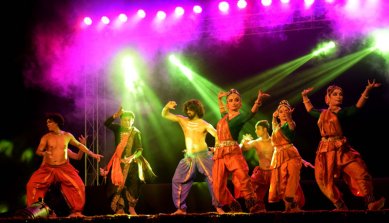
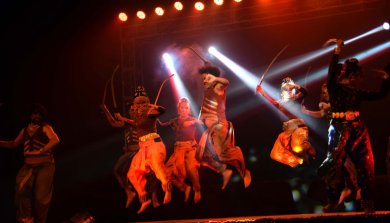
Abhimanyu Vadha, the new choreographic work from Dronaparva of Mahabharata unfolded with Dronachaya's anxiety. Vanashree has employed the technique of flash back. Dronacharya on the battlefield reflects on the futility of the war and the killing of young Abhimanyu. In the next scene we see Arjuna telling Subhadra the secret of how to fight when Chakravyuha, the military formation, is to be created to defeat Pandavas. Arjuna and Subhadra walk into a garden. Arjuna tells Subhadra about the various ways by which the soldiers will be defeated. Overcome by fatigue, Subhadra falls asleep. Abhimanyu as fetus in Subhadra's womb listens carefully to what Arjuna explains. But after Subhadra falls asleep, he does not learn how to come out of Chakravyuha. During the war, Yudhishthira takes Abhimanyu to the battlefield and promises him that he and other Pandava uncles will save him from Chakravyuha, strategic formation created by Dronacharya. Abhimanyu plunges into war with the Saptarathis, seven warriors, who surround him. Alone fighting valiantly Abhimanyu loses his weapons, is bodily injured and picks up the wheel of his broken chariot and tries to attack Dronacharya but falls, and Karna stabs him in the back. Helpless, Yudhishthira is unable to protect him as Jayadrath guarding the entry of Chakravyuha could not be defeated. The agony of Arjuna at the death of Abhimanyu is heart rending and he cries and promises to kill Jayadrath next day before the sunset. The dancers performed with dynamism and energy. Young Kuchipudi dancer Ranjini Nair played the role of Abhimanyu with incredible stamina. The male dancers surrounding Abhimanyu, lifting his body, Abhimanyu picking up the wheel of broken chariot and attacking, were performed with such intensity that one was glued to one's seat. Watching the anguished cry of Arjuna with his heart beating aloud to the excellent music accompanying the scene, one admired the choreography of the plot. What a gripping story it is - every time it is performed, it creates great sympathy for young Abhimanyu, the victim of the war. Creating a bridge with dancers bending in one line, over which Abhimanyu walks and wields sword, attacking the seven warriors was choreographed imaginatively. Lifting Abhimanyu in the air showing his frame up above the warriors by the male dancers in Mayurbhanj Chhau technique suited the war scene. The speed with which the dancers moved from one end of the stage to another and from raised platform behind, fighting, giving battle cries succeeded in creating atmosphere of battle, fought with do or die energy. The impact was further enhanced by specially composed war music with special effects. I happened to see this performance for the second time, after an interval of a year. It held the same magic in its exposition. The finale was a group tillana in Sindhubhairavi raga. Vanashree took a challenge to choreograph in three styles, which moved from one to another in a seamless manner. Nattuvangam by Dr. S.Vasudevan was impeccable. The lilting, graceful movements by Kuchipudi dancers, flawless Bharatanatyam by Vasudevan and perfectly synchronized Mayurbhanj Chhau movements by four male dancers were executed to the excellent musical score. With a prayer in the end, Vasudevan offering salutations to the deity, other dancers taking still poses in Kuchipudi and Mayurbhanj Chhau technique looked impressive for the coordination. The tillana brought down the house and dancers received standing ovation. It would be invidious to single out any one dancer as the group performed with understanding as a team and gave their best. With music providing excellent support to various moods and basic veera rasa for battle scenes the title of the group ‘Rasa United' indeed justified it. The tillana brought the presentation to a joyous end. Besides group choreography by Vanashree Rao, on the first day classical vocal music by Bombay Jayshree followed by Shubhendra Rao's sitar were arranged. Unfortunately, outside the school, another religious discourse was going on with microphones blaring loud. Somehow Bombay Jayshree and her accompanists managed to perform well so the disturbance by the sound was mitigated to some extent, though Shubhendra Rao's recital was partly affected by the noise. Next day before Rasa United's performance, vocalist Pandit Ulhas Kashalkar presented a memorable Hindustani vocal recital. 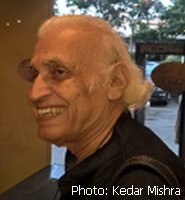 Dr. Sunil Kothari is a dance historian, scholar, author and critic, Padma Shri awardee and fellow, Sangeet Natak Akademi. Dance Critics' Association, New York, has honoured him with Lifetime Achievement award. Post your comments Please provide your name and email id when you use the Anonymous profile in the blog to post a comment. All appropriate comments posted with name & email id in the blog will also be featured in the site. |